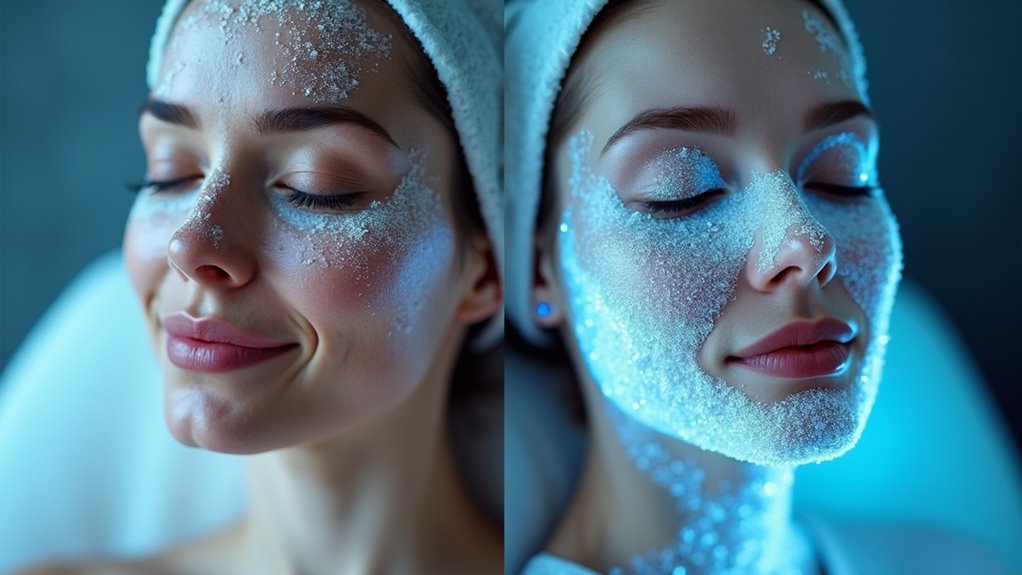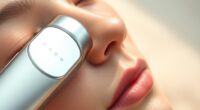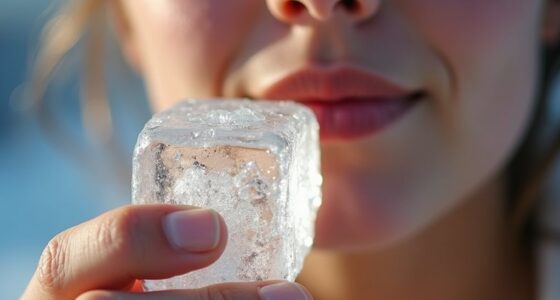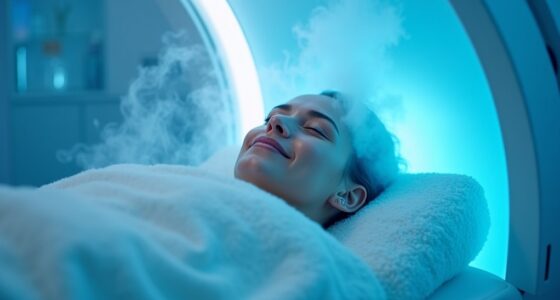An ice facial uses crushed ice or ice packs to gently tighten pores and reduce inflammation, making it great for quick calming. A cryo facial, on the other hand, involves specialized devices that deliver controlled cold air or liquid nitrogen for deeper skin rejuvenation and collagen boost. While ice facials are simpler and often at-home friendly, cryo treatments are more precise and performed by professionals. Continue exploring to discover which option suits your skincare goals best.
Key Takeaways
- Ice facials use crushed ice or cold packs for quick calming and pore tightening, ideal for sensitive skin.
- Cryo facials employ specialized devices with controlled cold air or liquid nitrogen for targeted skin rejuvenation.
- Ice facials are simple, affordable, and performed at home or in basic settings; cryo treatments require professional equipment.
- Cryo offers more precise, long-term benefits like collagen stimulation and skin tightening, while ice facials provide immediate soothing.
- Risks differ: ice facials are low-risk if done properly, but cryo treatments need trained professionals to ensure safety.
The Basics of Ice and Cryo Facials
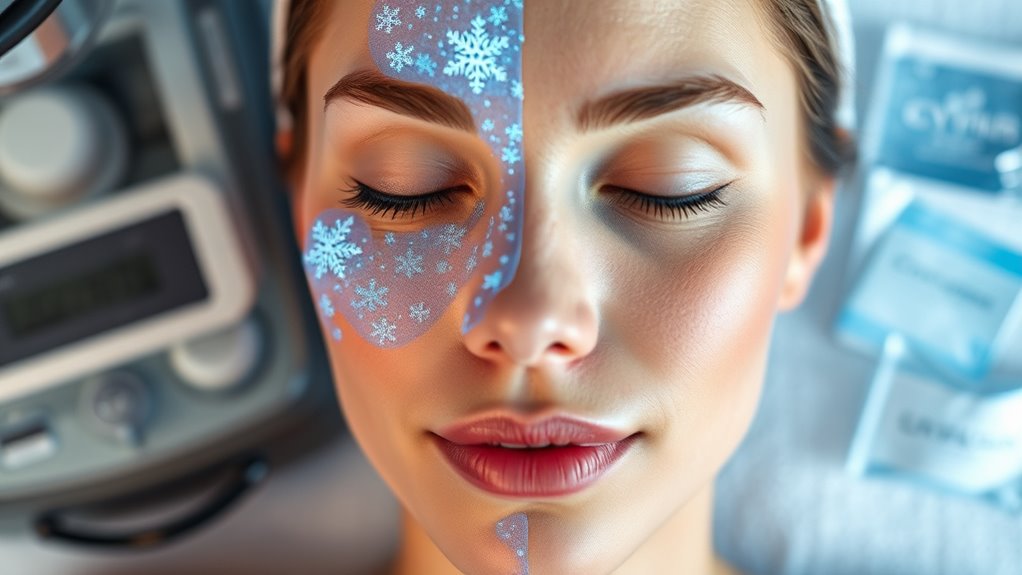
Ice and cryo facials are popular skincare treatments that use cold to rejuvenate the skin. Ice therapy involves applying ice or cold packs directly to the skin, helping reduce inflammation, tighten pores, and boost circulation. Cryo technology, on the other hand, uses specialized devices that emit controlled cold temperatures to target specific skin areas more precisely. These treatments stimulate blood flow and encourage cell renewal, giving your skin a refreshed appearance. While ice therapy is simple and often done at home, cryo technology is typically administered by professionals with advanced equipment. Both methods leverage the power of cold to improve skin health, but cryo facials tend to offer more targeted and intense benefits thanks to their precise temperature control. Additionally, cryo facials often incorporate advanced technology to optimize results and ensure safety during treatment.
Techniques and Procedures Involved
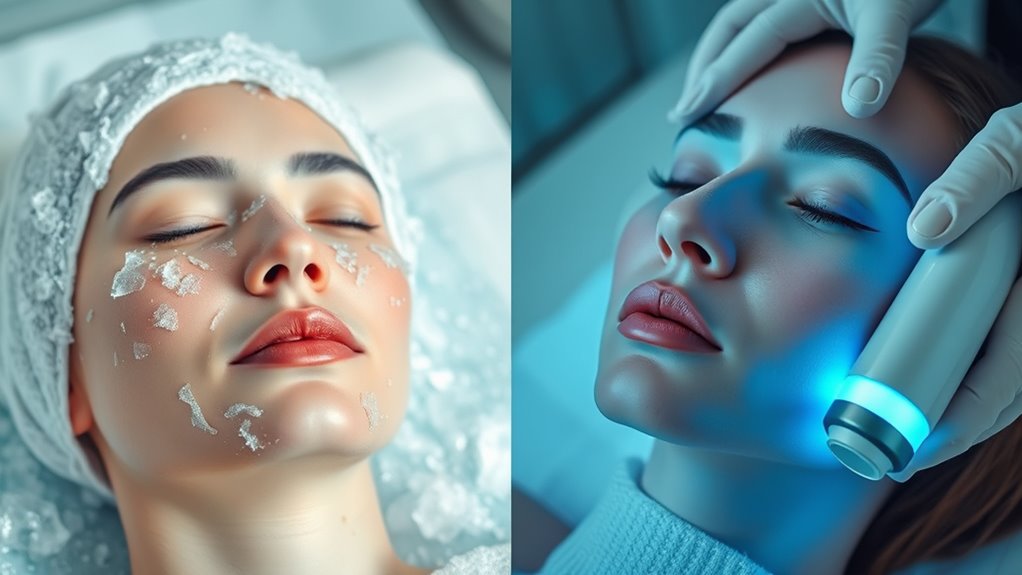
The techniques used in ice and cryo facials vary in complexity and precision. In an ice facial, cold therapy involves applying crushed ice or ice packs directly to your skin, often wrapped in cloth to prevent frostbite. This simple method promotes circulation and temporarily tightens your skin. Cryo facials, on the other hand, use controlled, cold air or liquid nitrogen-based devices to deliver precise cold therapy. These procedures typically involve a technician moving a specialized device across your face, targeting specific areas for skin rejuvenation. The goal is to stimulate collagen production and reduce inflammation. While ice facials are more straightforward, cryo treatments are more advanced, offering a controlled and consistent cold application that enhances skin rejuvenation with minimal discomfort. Cold therapy techniques are designed to maximize skin benefits while minimizing risks.
Primary Benefits of Each Treatment
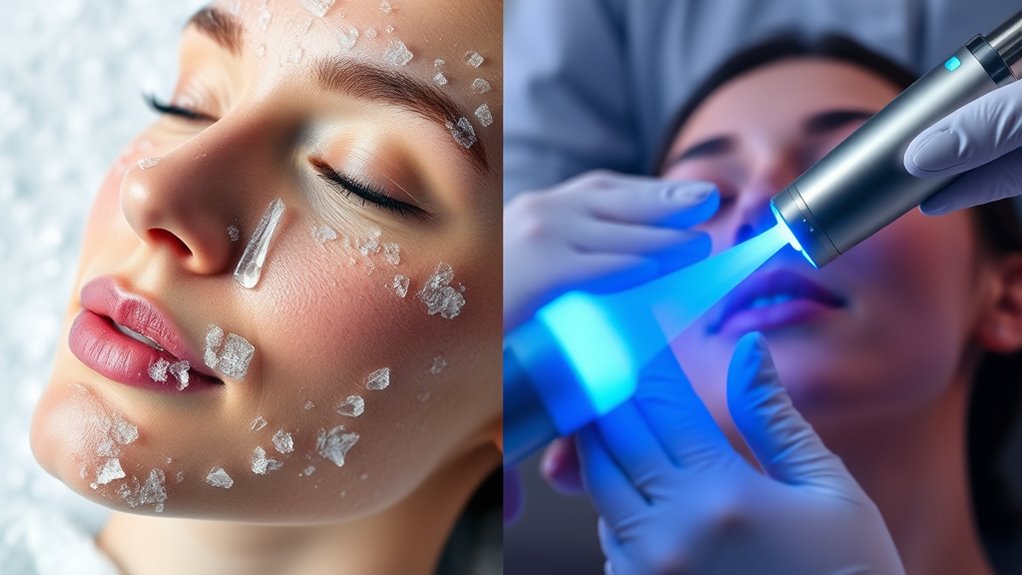
While both ice and cryo facials offer notable skin benefits, their primary advantages differ based on their approach. Ice facial benefits include reducing inflammation, calming irritated skin, and tightening pores, making your skin look refreshed and smoother. It’s especially helpful if you’re dealing with redness or puffiness. On the other hand, cryo facial advantages focus on stimulating collagen production, boosting circulation, and providing a cooling, rejuvenating effect. This treatment can improve skin elasticity and reduce the appearance of fine lines over time. Both treatments promote a healthier, more radiant complexion, but ice facials are ideal for quick calming and tightening, while cryo facials target long-term skin renewal and anti-aging effects. Understanding skin improvement techniques helps you choose the right option for your skin needs.
Potential Risks and Precautions
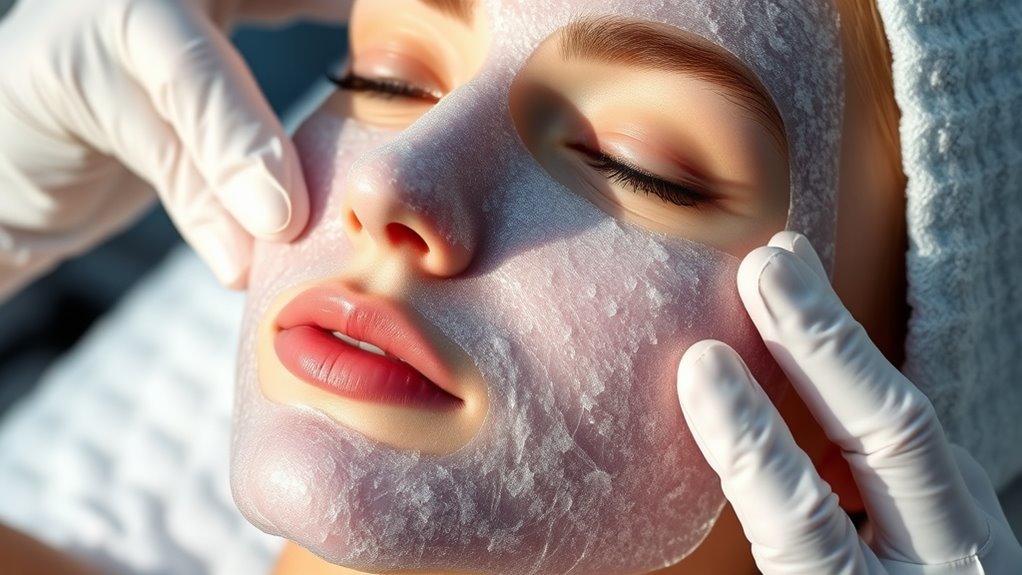
You should be aware that skin sensitivity can increase your risk of irritation or injury during these treatments. It’s vital to follow proper procedures closely to avoid adverse effects. Always consult with a professional to guarantee safety and suitability for your skin type. Additionally, understanding air purifier technologies can help you recognize how different treatments may impact skin health and overall safety.
Skin Sensitivity Concerns
Because both ice and cryo facials involve extreme cold, they can pose risks for individuals with sensitive skin. If your skin reacts easily to temperature changes, you might experience redness, irritation, or even discomfort during or after the treatment. Cold exposure can interfere with your skin’s ability to regulate temperature properly, leading to an imbalance that worsens sensitivity. Additionally, prolonged or intense cold can compromise skin hydration, causing dryness or peeling. If you have a history of skin conditions like eczema or rosacea, these treatments may exacerbate symptoms. Always consult with a skincare professional before trying either facial, especially if your skin is prone to sensitivity. Taking precautions guarantees you protect your skin’s natural barrier and avoid unwanted reactions.
Proper Procedure Adherence
Adhering to proper procedures is essential to guarantee safe results during ice and cryo facials. Always follow your provider’s instructions closely, especially regarding treatment duration and intensity. Proper procedure adherence helps prevent potential risks like skin irritation or frostbite. Make sure the clinic has proper accreditation, ensuring they meet safety standards and use quality equipment. After your facial, prioritize post treatment skincare by keeping the skin moisturized and protected from the sun. Avoid aggressive scrubbing or harsh products that could irritate your skin. If you experience discomfort or unusual reactions, contact your provider promptly. Following these precautions minimizes risks and maximizes benefits, making your facial experience both safe and effective. Trust in well-regulated clinics and proper protocols to achieve ideal results. Additionally, understanding home care routines can help maintain the benefits of your treatment and support skin health.
Suitability for Different Skin Types
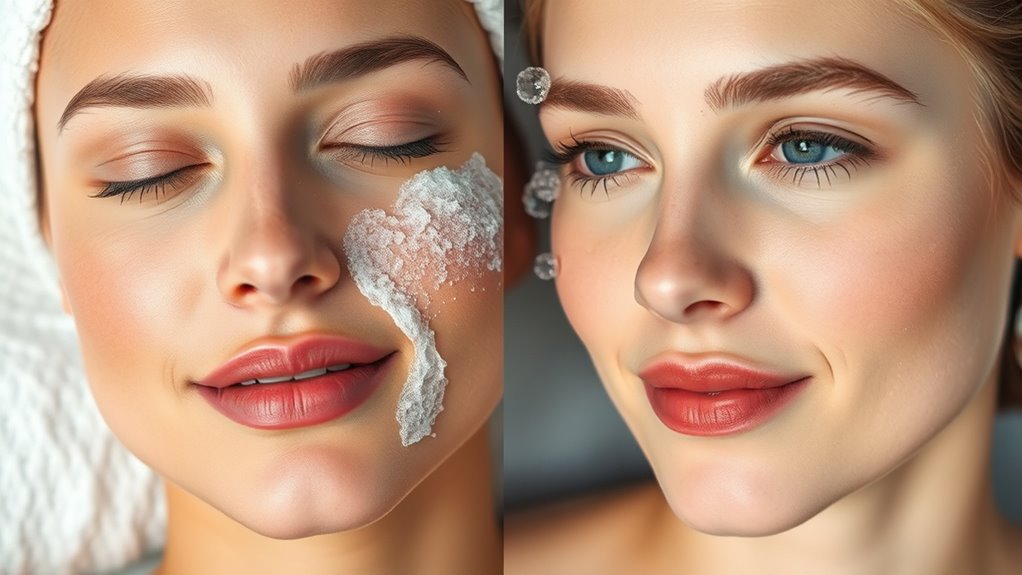
Are ice facial and cryo facial suitable for all skin types? Not necessarily. Ice facials are gentle and often ideal for sensitive or redness-prone skin, helping with pore tightening and maintaining skin hydration. Cryo facials, which involve colder temperatures, may be more beneficial for oily or acne-prone skin due to their anti-inflammatory effects. However, individuals with very dry or sensitive skin should approach cryo treatments cautiously, as intense cold can cause irritation. Here’s a quick comparison:
| Skin Type | Suitable Treatment |
|---|---|
| Sensitive/Redness-prone | Ice facial for gentle pore tightening |
| Oily/Acne-prone | Cryo facial for anti-inflammatory benefits |
| Dry/Sensitive | Consult before treatment; cautious approach |
| Normal skin | Both options work well |
Always consider your skin’s unique needs before choosing a treatment. Additionally, understanding the benefits of different cold therapies can help you make an informed decision.
Cost and Duration of Treatments
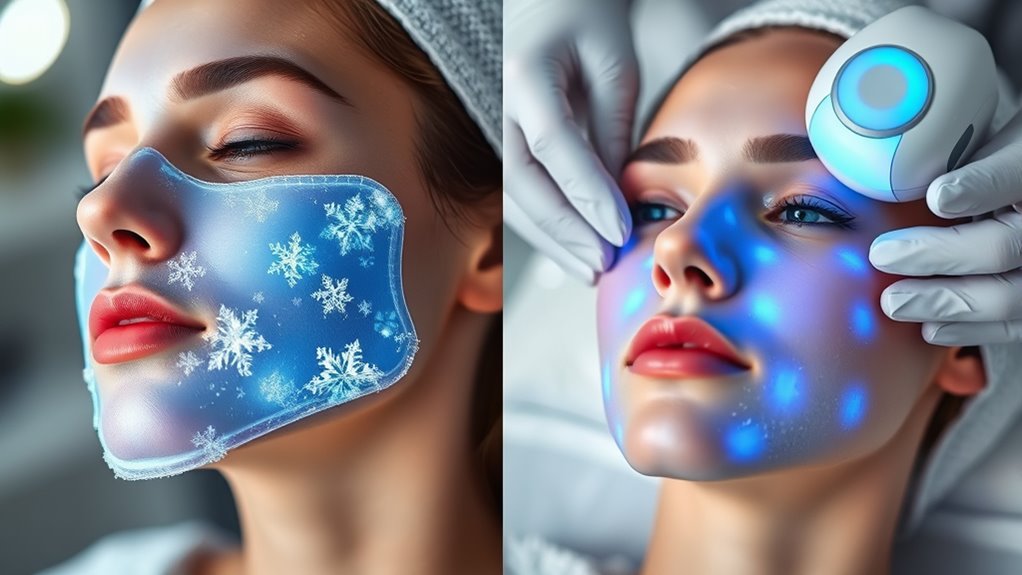
When choosing between an ice facial and a cryo facial, understanding the costs can help you decide what’s affordable. You’ll also want to take into account how long each session lasts, as treatment durations can vary. Let’s compare the price ranges and session lengths to find the best fit for your needs. Additionally, considering the treatment effectiveness can ensure you select the option that provides the best results for your skin concerns.
Treatment Cost Comparison
Ice facials typically cost between $50 and $150 per session, lasting about 20 to 30 minutes, making them an affordable option for many. When considering a price comparison, you’ll notice that ice facials tend to be less expensive than cryo facials, which can range from $200 to $600 per session. For an affordability analysis, think about your budget and how often you want treatments. Incorporating cost analysis allows you to weigh the expenses against potential benefits and treatment outcomes. Here are some key points:
- Ice facials offer a lower initial investment per session.
- Cryo facials, although pricier, may require fewer treatments for similar results.
- Your choice depends on your budget and long-term skincare goals.
Understanding these costs helps you make an informed decision aligned with your financial comfort.
Session Length Variations
While both ice and cryo facials aim to rejuvenate your skin, their treatment session duration can vary considerably, impacting your overall time commitment and cost. An ice facial typically lasts around 20 to 30 minutes, making it a quick option that fits easily into your schedule. In contrast, a cryo facial often requires 30 to 45 minutes, depending on the treatment specifics. This difference influences appointment scheduling, as you may need to allocate more time for cryo sessions. Longer treatment durations can also affect the cost, with longer sessions generally being more expensive. If your schedule is tight, an ice facial’s shorter treatment session duration might be more convenient. Always check with your provider to plan appropriately based on your available time and desired results. Store essential oils properly to ensure the treatments remain safe and effective.
Choosing the Right Facial for Your Skin Goals
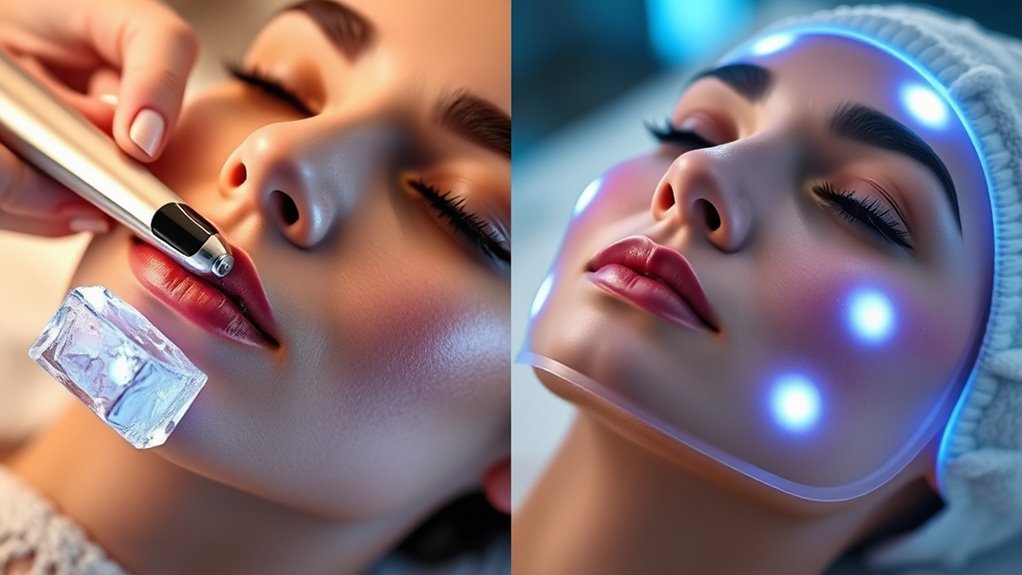
Choosing the right facial depends on your specific skin goals and concerns. To determine the best option, consider what you want to achieve. Here are some tips:
- If you aim to reduce inflammation or puffiness, an ice facial may be ideal, and you can try DIY remedies at home.
- For anti-aging or skin tightening, a cryo facial offered in spa package options could deliver better results.
- If you’re new to facials, start with a basic spa treatment to assess how your skin responds before exploring specialized options.
- Understanding the different skincare treatments available can help you make an informed choice that aligns with your skincare goals.
Knowing your goals helps you select the right treatment, whether DIY remedies or professional spa options. Always consult with a skincare professional to personalize your facial routine for ideal results.
Frequently Asked Questions
How Long Do the Effects of Each Facial Typically Last?
You’re wondering about facial longevity and treatment duration. Typically, the effects of an ice or cryo facial last around 3 to 7 days, depending on your skin type and skincare routine. To maintain results, you might need regular treatments every few weeks. Keep in mind, individual experiences vary, but consistent care can help prolong the benefits and keep your skin looking refreshed and vibrant longer.
Can These Facials Be Combined With Other Skincare Treatments?
You can definitely combine treatments like ice or cryo facials with other skincare procedures. Combining treatments enhances skincare integration, providing better results and addressing multiple skin concerns simultaneously. Just consult with your skincare professional to create a tailored plan that complements your skin type and goals. They’ll guide you on the best order and timing to maximize benefits without overloading your skin or causing irritation.
Are There Any Specific Skin Conditions That Contraindicate These Facials?
If you have sensitive skin or rosacea concerns, you should be cautious before trying ice or cryo facials. For example, someone with rosacea found that cold treatments aggravated redness and inflammation. These facials may worsen symptoms for those with skin conditions that involve broken blood vessels or heightened sensitivity. Always consult your dermatologist to evaluate whether these treatments suit your skin type and to avoid potential adverse reactions.
How Often Should One Get an Ice or Cryo Facial for Optimal Results?
For ideal results, you should follow the recommended frequency guidelines for ice or cryo facials, typically scheduling treatments every 2 to 4 weeks. This maintenance schedule helps boost collagen, reduce inflammation, and improve skin tone without overdoing it. Listen to your skin’s response and consult your skincare professional to adjust the frequency if needed, ensuring you get the best benefits while avoiding irritation.
Do These Treatments Require Any Post-Procedure Skincare Routines?
Think of your skincare routine as a trusty knight’s armor. After an ice or cryo facial, you should focus on post facial hydration to soothe your skin and maintain results. Applying a gentle moisturizer and staying hydrated are key. Don’t forget sun protection—wear SPF daily to shield your skin from UV damage. This simple routine helps your skin recover faster and keeps your glow lasting longer.
Conclusion
If you’re considering an ice or cryo facial, think about your skin goals. For example, if you want quick redness reduction before a big event, an ice facial might suit you. On the other hand, if you’re seeking long-term firming and glow, a cryo facial could be better. Both treatments can refresh your skin—just choose based on your needs, budget, and skin type. Either way, you’ll leave feeling rejuvenated and radiant.
